Lots of people tend to research for months about which is the best electric guitar when what they really need is to get started playing and practicing. Becoming an elite player requires time behind a solid axe picking and strumming. What a beginner needs is an electric that is generally great so they can learn over time what specific nuances they care about, and that’s what we discuss and share today…

Compared to acoustic guitars, electric ones have been around for a fairly short period of time. We are talking 60 to 70 years of active use. Even so, this instrument has completely changed the way we understand music.
The electric guitar’s almost unlimited flexibility is exactly why so many people start their journey of learning how to play it each year. If this is you right now, you are in the right place. We have tried
Need more information in order to better understand your needs and navigate the vast guitar world? We have got you covered! Visit our FAQ section.
Included in this guide
| Epiphone Les Paul Special II | Best Budget Guitar | Buy on Amazon |
| Squier Bullet Mustang | Best for Kids and Smaller Players | Buy on Amazon |
| Squier Classic Vibe ’60 Stratocaster | Best Beginners Guitar | Buy on Amazon |
| Epiphone Les Paul Standard | Best Value for Quality Guitar | Buy on Amazon |
| PRS SE Custom 24 | Most Versatile | Buy on Amazon |
| IBANEZ Genesis Collection RG550 | Best Guitar for Metal and Shred | Buy on Amazon |
| Fender American Ultra Telecaster | Best of the Best | Buy on Amazon |
Epiphone Les Paul Special II
Epiphone’s Les Paul series was originally designed to allow the budget crowd to experience this awesome guitar without investing thousands of dollars. That’s something that hasn’t changed to this day. The Epiphone Special II is among the most basic Les Paul designs on offer, making it perfect for beginners.
It’s made of mahogany and finished with an attractive vintage sunburst pattern. It features a pair of 700T humbuckers, one at the bridge and one at the neck position which although pretty basic in nature are than good enough even for more experienced players and important recordings.
We love this particular guitar because of its neutral configuration which will keep up with you even after you’ve built plenty of skill. It sounds great, handles distortion well and holds intonation nicely. At this price, the value you get is great, to say the least.
Specs:
- Scale length: full scale
- Color: Vintage sunburst
- Body materials: Okoume (top), Okoume (back)
- Neck type and material: Okoume
- Fretboard material: Rosewood
- Pickups: 700T Humbucker pickups
Pros:
- Great sound
- Versatile product perfect for beginners and intermediate players
Cons:
- Heavier than other beginners’ guitars
Squier Bullet Mustang

Learning a new instrument is no joke and the worst thing that can happen is for you to get bored after just a couple of lessons. The Bullet Mustang will conquer you with its captivating look, ease of play and great sound. This mighty entry level guitar is famous for being one of the best (and most fun to play!) beginners’ guitar – we are confident it will keep you motivated and entertained at each steps along your guitar journey.
Its smaller scale makes it the perfect guitar for younger and smaller players as well as for those new to the instrument that are practicing and developing their technique. Although aimed at beginners, it delivers sophisticated tones which can be appreciated by more capable players looking for a budget yet quality guitar. Squier is the budget-friendly arm of historic guitar manufacturer Fender synonym of quality and innovation and the Bullet Mustang is no exception.
Specs:
- Scale length: 24”
- Color: Imperial blue
- Body materials: Basswood (top), Basswood (back)
- Neck type and material: Maple
- Fretboard material:
- Pickups: humbucking pickups
Pros:
- Perfect for kids and beginners
- Great tones
- Amazing price tag
Cons:
- May be too small for older players
Squier Classic Vibe ’60 Stratocaster
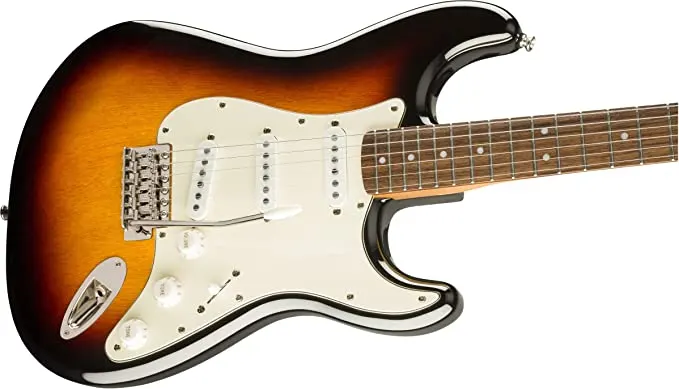
The Squier Classic Vibe ‘60s Stratocaster is possibly one of the best entry-level guitars out there.
In terms of value for money and versatility, there’s probably nothing else in this price range. It’s a budget tribute to the famous model from Fender yet it is able to recreate the high-end feel of the original model. It boasts 1960s style tuners, and headstock markings and a comfortable and slim C shaped neck which provide excellent comfort. Thanks to a trio of Fender-designed alnico single-coil pickups you can expect some real and high quality Strat tone and a whole range of styles, effortlessly stretching from blues to rock. without having to pay the hefty price tag associated with Fender vintage models.
The Classic Vibe models are built with high-quality materials meaning they sound great and last long too!
Specs:
- Scale length: full size
- Color: Sunburst
- Body materials: Nato (top), nato (back)
- Neck type and material: Maple
- Fretboard material: Laurel
- Pickups: Fender-Designed alnico single-coil pickups
Pros:
- Stratocaster design
- Versatile and durable
Cons:
- Entry-level guitar which may feel low quality to more advanced players
Epiphone Les Paul Standard
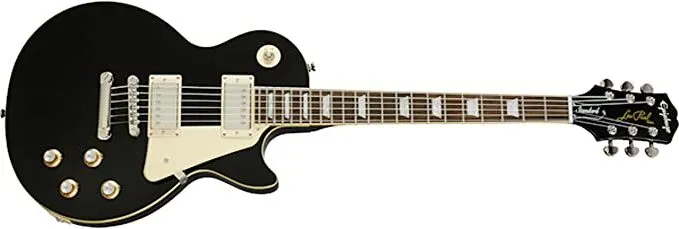
B084HGPJNL
We’ve already shown you one of Epiphone’s Les Pauls. However, that guitar and this model we’re looking at here are simply not comparable. Les Paul Standard features a much better set of pickups as well as hardware.
Each of the four available finishes on this thing is superb and includes a number of subtle details which really add to the beauty. Most importantly, Epiphone’s Les Paul Standard will give you a true taste of what a legit Gibson Les Paul tastes like without breaking the bank. The tonewood of choice is mahogany, as expected, but this time it comes with a maple top. The top of the guitar arches slightly just like the original Les Paul does.
Classic rock and blues just flow out of these, although you are more than free to crank up the gain and blast some heavy riffs.
Specs:
- Scale length: full size
- Color: Ebony
- Body materials: Mahogany (top), Mahogany (back)
- Neck type and material: Mahogany
- Fretboard material: Indian Laurel
Pros:
- Les Paul design
- High-quality parts
- Ideal first guitar for blues-based rock guitarist
Cons:
- There may be cheaper alternatives available
PRS SE Custom 24
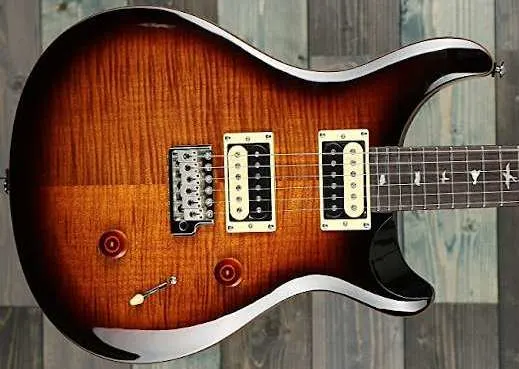
Most guitars out there usually feature a version of either one of many Gibson designs or Fender ones, but there are exceptions. Paul Reed Smith is a brand that took their own path in just about every aspect of guitar design. This made it popular with many famous guitar players, most notably Carlos Santana.
The body of the PRS SE Standard 24 is made of mahogany which feels very comfortable to play even though mahogany isn’t the lightest tonewood out there.
The balance offsets any weight issues. The neck is a maple piece that comes with a standard rosewood fretboard and PRS classic bird inlays. The pickups PRS chose for this build are their S2 HFS Treble and S2 HFS Vintage Bass units. Their performance and color are pretty unique when compared to other designs out there.
Overall, this guitar is a bit different and pushes its own tone thanks to PRS’s pursuit of their own style. It’s among the most respected designs in the business, and for a good reason too.
Specs:
- Scale length: full scale
- Color: black gold sunburst
- Body materials: maple, rose or mahogany
- Neck type and material: maple
- Fretboard material: mahogany
- Pickups: 2 Humbucking Pickups
Pros:
- High-quality, solid materials and reliable instrument
- Great custom finishes
- Solid tone
Cons:
- Slightly heavier than most
IBANEZ Genesis Collection RG550

They say great players can make great music with all instruments however, while that may be true, if you are specializing in a specific music genre having an instrument that was made for such genre can come a long way. If metal or more generally heavy styles are your jam, enters the IBANEZ Genesis RG550. This famous model was recently reissued, it boasts the body design, the ergonomics and the hardware proper of the best metal instruments.
Historically, the Ibanez RG550 was the aspirational guitar for teenagers and young players, the unconventional, competitor to Fender and Gibson. Expensive enough to make it high-end, but affordable enough to make it a realizable dream. Nowadays, it still rare combination of high-quality materials, captivating design with a revolutionary sentiment
Specs:
- Scale length: full scale
- Color: Road Flare Red
- Body materials: basswood
- Neck type and material: maple / walnut
- Fretboard material: maple
- Pickups: V7 neck pickup, S1 middle pickup, and V8 bridge pickup combination
Pros:
- Iconic metal / shred guitar
Cons:
- Design and finishes are not for everyone
Fender American Ultra Telecaster

The American Ultra is the most advanced series of Fender’s guitars and basses for very demanding players looking for the best performing instrument and the best tone. It features a unique “Modern D” neck profiles and tapered neck heels. The fingerboard has a compound 10”-14” radius and medium-jumbo frets for a contemporary feel.
The real deal in terms of tone are the Ultra Noiseless Vintage single coils delivering a fat, clear tone without the hum.
Other notable features include Fender’s locking tuners and Ultra-exclusive finish options (5 different variations).
The Telecaster has been historically considered one of the best electric guitars for country music however it delivers superb rock and blues performances.
Specs:
- Scale length: full scale
- Color: Texas tea
- Body materials: alder
- Neck type and material: maple
- Fretboard material: rosewood
- Pickups: Two Ultra Noiseless Vintage Tele single-coil pickups
Pros:
- Strong build, playable guitar
- Noiseless pickups
- Fender locking tuners
Cons:
- No version for left-handed people
FAQs
Today we are going to go over everything you need to know about these sweet electric axes. The first portion of this article is going to be a guide of sorts.
After that, we’re going to show you some of the absolute best guitars on the market divided into several price ranges.
By the time you are done reading, you should be armed with all the necessary information to step into the world of electric guitars with the confidence to choose (and use) a guitar for yourself or to snag one as a gift for someone else. With that said, let’s get going with…
Electric Guitars 101: What You Need to Know
There are a handful of things you need to be aware of when it comes to guitars. Our recommendations eliminate the need to be hands-on and continually involved with complicated parts, but you should still know they are there and what they do.
How Does An Electric Guitar Work?
Believe it or not, the basic principle behind electric guitars is fairly simple. So much so that people had experimented with it in the early 20th century, even though the first commercial model came several decades later. The whole point and main emphasis is in the pickups.
These pickups rely on electromagnetic induction to “pick up” the vibration of the strings. Basically, it emits a magnetic field and as the string vibrates through it this generates an electrical current, which is your audio signal.
This information is then sent on to an amplifier. The reason why you need an amplifier is that the original signal from the guitar is not strong enough to be pushed through a loudspeaker without a boost from the amp.
That’s why you often times hear terminology such as “instrument level” and “speaker level” signals. Using magnetic pickups to record vibrations works great but is considered the old school way at this point in time. Nowadays we have other solutions which aren’t too different in nature, but a bit more efficient.

The way sound is created is ultimately the main difference between acoustic and electric guitars. What acoustic guitars achieve with the resonator box, electric guitars do with pickups. However, the versatility of an acoustic guitar is nowhere near the level where electric guitars operate. More on that later.
The Main Components Of An Electric Guitar
Even though electrics are fairly unique in nature, they still feature many of the same components and parts you find on other types of guitars. Let’s name them and talk a bit about how each component contributes to the performance of a guitar.
The Body
This part of the guitar seems pretty straight forward at first due to some common assumptions. Most people tend to think that the tonewood used for the body of an electric guitar has no impact on the sound like it does on an acoustic.
After all, it’s not like the body is amplifying the sound, right? Wrong!
Even though pickups are the main component tasked with interpreting string vibrations and indirectly turning them into sound, your choice of wood still matters. Although the effect is subtle, certain woods will give you better sustain, more definition, and so on. And in the end it’s the accumulation of all of these choices that determine your ultimate sound.

Which tonewood works the best for you will depend on your personal preference as well as the genre of music you’re playing. Electric guitar bodies come in a whole range of styles.
You have classics such as the Stratocaster and the Les Paul shape, but there’s much more out there to explore. Granted, a vast majority of these were heavily inspired by the aforementioned models and you probably don’t want to go too far off into the realm of the strange.
Electric Pickups
As you probably figured out by now, pickups are the “meat and ’taters” of the whole instrument. No matter what, this is the component that has the biggest impact on the flavor of your sound. With that said, it is important to know and understand different types of guitar pickups.
We can boil everything down to two separate, standard classifications: single coils and humbuckers, both of which are either active or passively powered.
Single Coils & Humbuckers
If you were to open just about any magnetic pickup, you would find thousands of layers of wire wound around a coil former. Single coil pickups feature one coil and were the standard up to 1955. The issue with single coil pickups is the interference that shows itself in form of an underlying buzzing whenever you plug in your guitar.
That’s still something even the most modern single coil guitars have to deal with. A classic example of a single coil guitar is the Fender Stratocaster. If you look at the front face of this Fender Roadhouse Strat body, you will see three single coils arranged in the standard configuration.

Right around 1955, Gibson found a solution for this annoying yet tolerable buzzing issue. What they did was to essentially put two single coils together, aligning the polarity of magnets in opposite directions, and wiring them out of phase.
This design eliminated the buzzing and humming, creating a whole new type of pickup – the humbucker. Humbuckers generally have much more audio girth and deal a lot better with distortion.
Choosing between humbuckers and single coils is a personal decision. Both are equally popular and are considered as standards. The only thing to remember is that single coils are better suited for lighter genres of music while humbuckers are the standard for heavier stuff.
Also, it is worth noting that cheap single coils generally tend to suffer much more from that buzzing. If you find yourself stuck with a cruddy one, you can always install a better one from a more reputable company.
Active & Passive Pickups
Guitar pickups, both single-coils and humbuckers, can be active or passive. The latter is the older design and represents a classic magnetic pickup we have talked about so far.
Active pickups are much newer and bring a number of solutions to the table for several minor annoyances. Let’s take a close look at each real fast.
Passive Pickups – To reiterate for comparison, passive pickups use thousands of layers of wire wrapped around a permanent magnet. When you pick a string, that string affects the magnetic field of the pickup below, generating a signal.
The deal with passive pickups is that their signal strength is constant. What you get is what you get. Pushing passive pickups to their limit causes feedback issues, introduces a certain level of noise and harmonic distortion, and so forth.
Active Pickups – Active pickups also feature numerous layers of copper wire, but there is one big difference. Instead of having thousands of layers, active pickups feature much less. This means that their inherent output is extremely low, which in turn is then boosted through a powered preamplifier.
Active pickups are wired straight to a preamp that is powered by a battery. Not only does this preamp section boost the signal to a level which passive pickups can’t even reach, but you can also shape the signal before it reaches the amplifier.
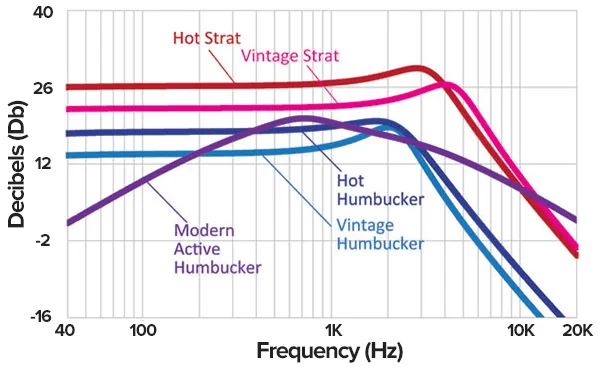
If you need to brush up on your preamplifier basics, you can read our article on the topic. But all you really need to know in this context is that they pre-amplify your tiny instrument-level electrical signal to line-level, which is much louder and what your amplifier or recording equipment will expect to receive.
Choosing Between Passive & Active Pickups
The very first thing to remember about pickups is that the active option is not necessarily better than the passive choice, and vice versa. Each type brings its own set of drawbacks and benefits.
Passive pickups might be limited in terms of signal strength and tone shaping, but they are much more expressive in comparison to the active pickups in terms of picking and strumming intensities.
On the other hand, the inherent nature of active pickups allows them to have a much higher output and almost no noise pollution in the signal. Deciding between the two is more of a personal decision than anything else these days. The noise isn’t significant enough to push you away.
Now let’s move the discussion to the next guitar component…
Bridge
Bridges on electric guitars can either be extremely complex or simple. It all depends on which type you go for.
We’re going to mention the most popular types of bridges used today, the ones you’re most likely to run into. Knowing what each type of bridge offers is important in a sense that you will know exactly what you can or cannot do with it.
Fixed Bridge
In the grand scheme of things, fixed bridges are as simple as it gets. Aside from saddles, which are used to tune in intonation, there are usually no other moving parts involved.
The benefit of fixed bridges is their ability to retain intonation and tuning over time. If you’re just starting out, sticking with a fixed bridge will make your life much easier. However, it does have its limitations compared to a tremolo bridge.
Tremolo Bridge
A tremolo bridge can be imagined as a fixed bridge that moves. In other words, a tremolo bridge allows you to change the tension of the strings by manipulating the tremolo bar. There are two popular types of tremolo bridges from which most other are derived.
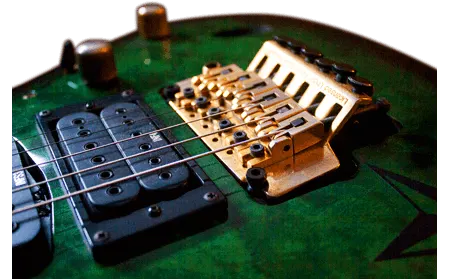
We have Fender’s tremolo design and the much more complex Floyd Rose, pictured above. Fender’s is the older type that still works great and is the choice many manufacturers use in tons of different guitars, while the Floyd Rose is an evolution of this design that is much more complex but also more reliable.
While tremolo bridges allow you to do all kinds of dive bombs and similar effects, they are harder to maintain. For example, changing strings on a Floyd Rose bridge is extremely complicated and takes a lot of finesse and patience. We recommend avoiding this as a beginner or intermediate player.
How To Choose the Best Electric Guitar?
The components mentioned above are the main ones that will impact not only the performance but also the price of a guitar. Now it’s time to figure out how to choose an electric guitar that fits your needs and abilities.
Thankfully, with the abundance of great models in all price ranges, this process isn’t all that complicated. Even so, there are some things you need to consider.
Budget
The best advice any guitar player can give when it comes to figuring out which guitar to get is to buy the best model your money can afford. In most cases, this advice is rock solid.
Even if you are a beginner who isn’t sure whether or not you want to commit to playing guitar long term, you can always sell the guitar with a minimal loss, like a decent car versus a junker. Think of it as an investment as long as you maintain and take care of it.
On the other hand, if you do decide to stick with it, having a good guitar means you won’t have to worry about upgrading in the foreseeable future when your skill levels rise above the problems associated with cheap options.
Realistically, no matter who you are or are buying for, you shouldn’t get the cheapest option. At least go middle-tier unless we’re talking about a 5 or 6 year old’s first guitar.
Genre
The truth is that you can play any genre of music with just about any type of electric guitar. Many blues players run Gibson Les Pauls with beefy humbuckers, while Iron Maiden completely broke the stereotype that you can’t play metal with a Stratocaster.
Guitar effects pedals really changed the game too. However, some guitars do actually deal better with certain music genres.
The general rule of thumb is to go with humbuckers if you’re into rock, metal and other genres where saturated distortion is the norm. Single coils are the staple of rock, classic rock, blues and lighter genres. Again, there are no straight rules but rather a set of guidelines.
Style
Here’s a cardinal mistake which many beginners make all around the world. They completely disregard their personal preference on account of what more experienced players tell them to buy. We have to tread lightly here, but here’s the main issue.
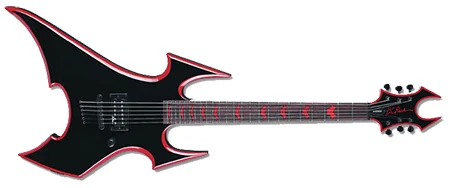
If you are not attracted to the way the guitar looks or feels in your hand, chances are you won’t be too eager to pick it up every day. When you are just starting out, this is supremely important.
Here’s where a disclaimer needs to be placed. This isn’t always the case, and often times people warm up to a guitar even if they didn’t initially like it, but why chance it?
All we want to say is that you shouldn’t disregard your personal preference when it comes to the style, shape, and feel of a guitar.
It matters more than the tiny feature a guitar nerd swears is a must-have to squeeze out 1% more performance… Way more.
Configuration
We mentioned different types of pickups and bridges earlier. When it comes to pickups, it’s completely up to you. Active guitars are going to be more expensive in most cases, so expect to spend a bit more on one. However, bridges are a whole different ball game.
We strongly suggest that you stick to a fixed bridge until that time when you are sure that you can service a tremolo bridge on your own. As a beginner and even intermediate, you don’t want to be bogging down in tech work or needing to pay the guy at the local shop to do a set-up every time you need to change strings.
These are the Best Electric Guitars Out There
Hopefully, this guide has given you all the info you need in order to go out there and find the perfect guitar for yourself. We went into some aspects of electric guitars that will shape your decision the most.
Beyond the ultimate considerations discussed between “this or that,” the rest is a matter of preference that only develops after you’ve had time to gain that much experience.
